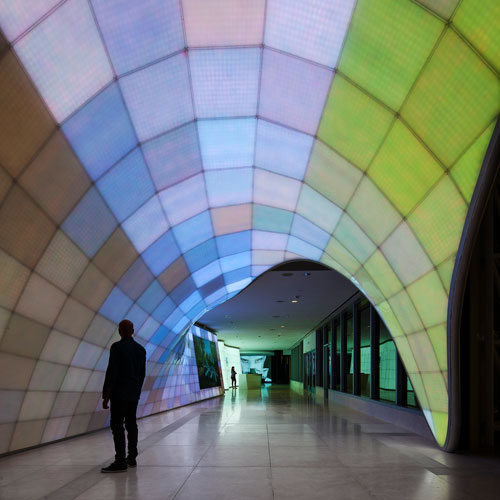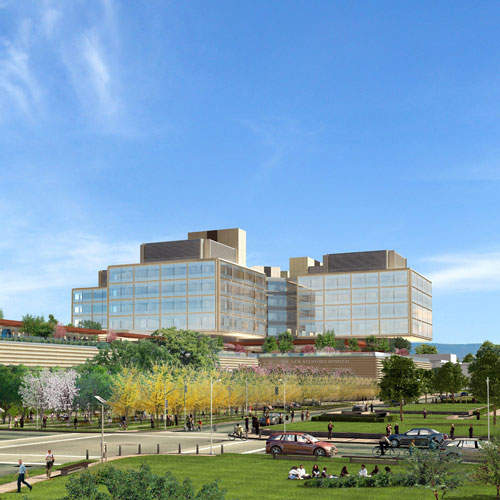This June, only a couple of months after the 50th anniversary of Martin Luther King Jr.’s march from Selma to Montgomery, Alabama, the new National Center for Civil and Human Rights (NCCHR) opened in Atlanta. The building is an important addition to the city’s portfolio of civic institutions, and it’s a visually unique addition to the burgeoning downtown tourist district, thanks largely to a multitonal façade formed with panels from Trespa International B.V.

conceived the design for the project. The two paneled walls are meant to interact like a pair of interlocking hands.
The center was first imagined by civil rights legend Evelyn Lowery and former United Nations Ambassador Andrew Young. Their goal was to create a safe space for visitors to explore the fundamental rights of all human beings, a space that would inspire and empower visitors to join the ongoing dialogue about human rights in their communities.
The NCCHR at a Glance
27,100
sq. ft. of paneling
2,286
total panels
99%
portion of uniquely cut panels
2
panel colors (amber and bronze)
4
colors that appear due to panel rotation
8 mm
panel thickness
4
months to install backup framing and panel extrusions
The actual design and construction of the $75 million, 42,000-square-foot center, driven forward by former mayor Shirley Franklin, dates back to 2009, when the Freelon Group, a North Carolina architecture firm behind a number of civic structures, won an international competition for the project after submitting an innovative design. Company founder and president Phil Freelon conceived a layout with two curved walls that wrap around most of the building in a way that suggests embracing hands—or, more symbolically, the interlocking hands of civil rights marchers coming together for a common cause.
To finish the walls that form the hands, Freelon used Trespa Meteon panels. The panels are divided into just two colors—amber, a color out of Trespa’s standard delivery program, and roman bronze, a custom formulation—but when the colors sit affixed to the curved walls of the building, the sun reflects off of them and creates the illusion of multiple shades of brown and tan, symbolic of the multiracial participants in the civil rights movement.
The panels also act together as a rain screen, allowing a continuous airflow through the cavity and aiding in the removal of heat and moisture from rain or condensation. “Because the goal of a rain-screen façade is to shed the majority of humidity that passes over the exterior of the building, open joints allow air flow behind the panels, thereby drying the cavity behind the panels,” says Zeke Miller, president of the Atlanta-based Miller-Clapperton Partnership, Inc.
The company, which has been fabricating Trespa Meteon panels since 2009, is one of a select number of Trespa North America’s “national fabricators.” Its expertise came into play during the installation of the NCCHR façade, which Miller says was extremely complicated due to the façade’s inward slope, with panels actually segmented to simulate a curve.

99 percent of the 2,286 panels used—which cover about 27,100 square feet of surface area—were uniquely cut, with only 26 panels duplicating others, and it took four months to install the backup framing and panel extrusions. “We had to lay out the rain-screen extrusion attachment system with a 3-D laser scanner, and our model for the project was used by all trades to do their layout,” Miller says.
The NCCHR—the third and final component of Pemberton Place, also home to the Georgia Aquarium and the World of Coca-Cola—sits on the corner of Ivan Allen Boulevard and Centennial Olympic Park Drive, where it stands out from the area’s other two buildings because of its connection to the environment and its gleaming paneling.
_______________________________________________________________________
 Material Spotlight: Trespa Meteon
Material Spotlight: Trespa Meteon
Trespa Meteon is a decorative high-pressure compact laminate with an integral surface. Its blend of up to 70 percent wood-based fibers and thermosetting resins, manufactured under high pressures and temperatures, yields a panel that’s stable and strong. Highly weather resistant, it comes in 8-millimeter, 10-millimeter, and 13-millimeter thicknesses and more than 300 possible finish and texture combinations, and it can be delivered with FSC credits. According to manufacturer Zeke Miller, it’s well suited for use with ventilated rain-screen façades because of its functionality and design diversity.
 Material Spotlight: Trespa Meteon
Material Spotlight: Trespa Meteon

